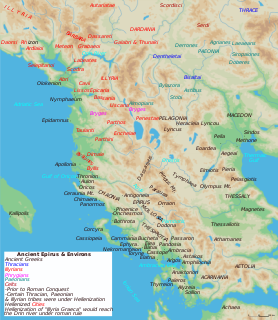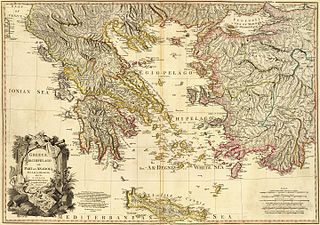 W
WAmantes or Abantes is a name of an ancient Greek tribe in the most northern part of Epirus. An ancient Greek polis Amantia, was named after them. There was also an Illyrian tribe with a similar name in Pannonia, the Amantini.
 W
WAthamanians or Athamanes were an ancient Greek tribe that inhabited south-eastern Epirus and west Thessaly. Although regarded as "barbarians" by Strabo and Hecataeus of Miletus, the Athamanians self-identified as Greeks. The existence of myths about Athamas and Ino in Achaean Phthiotis suggests that the Athamanians were settled there before 1600 BC. They were an independent semi-barbarian tribe and were occasionally allies of the Aetolians. Amynander and Theodorus of Athamania are reported kings of the Athamanians.
 W
WAtintanes or Atintanians was an ancient tribe in Epirus. It inhabited a region inland of the Epirote coast which was called Atintania. They were one of the Epirote tribes that belonged to the northwestern Greek group. They were occasionally subordinate to the Mollosians and spoke a northwestern Greek dialects similar to Doric Greek.
 W
WBryges or Briges is the historical name given to a people of the ancient Balkans. They are generally considered to have been related to the Phrygians, who during classical antiquity lived in western Anatolia. Both names, Bryges and Phrygians, are assumed to be variants of the same root. Based on archaeological evidence, some scholars such as Nicholas Hammond and Eugene N. Borza argue that the Bryges/Phrygians were members of the Lusatian culture that migrated into the southern Balkans during the Late Bronze Age.
 W
WThe Chaonians were an ancient Greek tribe that inhabited the region of Epirus located in the north-west of modern Greece and southern Albania. Together with the Molossians and the Thesprotians, they formed the main tribes of the northwestern Greek group. On their southern frontier lay another Epirote kingdom, that of the Molossians, to their southwest stood the kingdom of the Thesprotians, and to their north lived the Illyrian tribes. According to Virgil, Chaon was the eponymous ancestor of the Chaonians. By the 5th century BC, they had conquered and combined to a large degree with the neighboring Thesprotians and Molossians. The Chaonians were part of the Epirote League until 170 BC when their territory was annexed by the Roman Republic.
 W
WThe Dassaretae, or Dexaroi, were an ancient Greek tribe of Epirus living from Mount Amyron to Lake Lychnitis on the border with Illyria. They were the northernmost tribe that belonged to the Chaonian group, one of the three major tribes in Epirus. In Roman antiquity their territory was considered as part of Upper Macedonia.
 W
WThe Dorians were one of the four major ethnic groups among which the Hellenes of Classical Greece considered themselves divided. They are almost always referred to as just "the Dorians", as they are called in the earliest literary mention of them in the Odyssey, where they already can be found inhabiting the island of Crete.
 W
WThe Molossians were a group of ancient Greek tribes which inhabited the region of Epirus in classical antiquity. Together with the Chaonians and the Thesprotians, they formed the main tribal groupings of the northwestern Greek group. On their northern frontier, they neighbored the Chaonians and on their southern frontier neighbored the kingdom of the Thesprotians. They formed their own state around 370 BC and were part of the League of Epirus. The most famous Molossian ruler was Pyrrhus of Epirus, considered one of the greatest generals of antiquity. The Molossians sided against Rome in the Third Macedonian War and were defeated. Following the war, 150,000 Molossians and other Epirotes were enslaved and transported to the Roman Republic, overwhelmingly in Italy itself.
 W
WMycenaean Greece was the last phase of the Bronze Age in Ancient Greece, spanning the period from approximately 1600–1100 BC. It represents the first advanced and distinctively Greek civilization in mainland Greece with its palatial states, urban organization, works of art, and writing system. The most prominent site was Mycenae, in the Argolid, after which the culture of this era is named. Other centers of power that emerged included Pylos, Tiryns, Midea in the Peloponnese, Orchomenos, Thebes, Athens in Central Greece and Iolcos in Thessaly. Mycenaean and Mycenaean-influenced settlements also appeared in Epirus, Macedonia, on islands in the Aegean Sea, on the coast of Asia Minor, the Levant, Cyprus and Italy.
 W
WThe Molossians were a group of ancient Greek tribes which inhabited the region of Epirus in classical antiquity. Together with the Chaonians and the Thesprotians, they formed the main tribal groupings of the northwestern Greek group. On their northern frontier, they neighbored the Chaonians and on their southern frontier neighbored the kingdom of the Thesprotians. They formed their own state around 370 BC and were part of the League of Epirus. The most famous Molossian ruler was Pyrrhus of Epirus, considered one of the greatest generals of antiquity. The Molossians sided against Rome in the Third Macedonian War and were defeated. Following the war, 150,000 Molossians and other Epirotes were enslaved and transported to the Roman Republic, overwhelmingly in Italy itself.
 W
WParauaea was an ancient Greek region in Epirus. The area was incorporated into Macedon in 350 BC as part of Upper Macedonia. The Thesprotian tribe inhabiting it was called Parauaioi. Parauaei under king Oroedus and 1000 Orestai, entrusted to Oreoedus by Antiochus , their king, had joined the Spartans under Cnemus during the 3rd year of the Peloponnesian war. Rhianus calls them a Thesprotian nation, and so does Stephanus of Byzantium quoting Rhianus. Their name, Parauaioi meant, those dwelling beside Aous, a river in Epirus.
 W
WThe name Pelasgians was used by classical Greek writers to refer either to the ancestors or forerunners of the Greeks, or to all inhabitants of Greece before the emergence or arrival of Greeks aware of their Greekness. In general, "Pelasgian" has come to mean more broadly all the indigenous inhabitants of the Aegean Sea region and their cultures, "a hold-all term for any ancient, primitive and presumably indigenous people in the Greek world".
 W
WThe Thesprotians were an ancient Greek tribe, akin to the Molossians, inhabiting the kingdom of Thesprotis in Epirus. Together with the Molossians and the Chaonians, they formed the main tribes of the northwestern Greek group. On their northeastern frontier, they neighbored the Chaonians and on their northern frontier they neighbored the kingdom of the Molossians. The poet Homer frequently mentions Thesprotia, which had friendly relations with Ithaca and Doulichi. The Thesprotians originally controlled the Dodona oracle, the oldest religious shrine in Greece. Later, they were part of the Epirus until they were annexed into the Roman Empire.
 W
WThessaly or Thessalia was one of the traditional regions of Ancient Greece. During the Mycenaean period, Thessaly was known as Aeolia, a name that continued to be used for one of the major tribes of Greece, the Aeolians, and their dialect of Greek, Aeolic.
 W
WThe Molossians were a group of ancient Greek tribes which inhabited the region of Epirus in classical antiquity. Together with the Chaonians and the Thesprotians, they formed the main tribal groupings of the northwestern Greek group. On their northern frontier, they neighbored the Chaonians and on their southern frontier neighbored the kingdom of the Thesprotians. They formed their own state around 370 BC and were part of the League of Epirus. The most famous Molossian ruler was Pyrrhus of Epirus, considered one of the greatest generals of antiquity. The Molossians sided against Rome in the Third Macedonian War and were defeated. Following the war, 150,000 Molossians and other Epirotes were enslaved and transported to the Roman Republic, overwhelmingly in Italy itself.